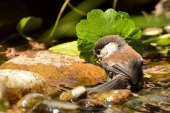Hello Permies !
I have been planning the grey water system for my semi-rural property in Transylvania, Romania, and two somewhat different solutions offer themselves - I will need to decide which route to take. I thought I could share these and hear your opinions with regard to pros and cons, and perhaps possible tweaks - and even alternatives?
Background: the property is in zone 5, continental climate (cold winters - temperatures of minus 20 degrees Centigrade are not uncommon, hence in winter, water running on the surface quickly turns into ice, and some elements like constructed wetlands have limited efficiency). Soil is heavy clay, with poor percolation.
The objective is to re-use the household grey water for garden irrigation, and/or turn it into water that is suitable for a small wildlife pond
I have read Art Ludwig's book on grey water, found it very useful and interesting, but the solutions he describes are not wholly suitable for my climate or my situation - although the general principles and some of his ideas were helpful in getting me started on my design.
What resonated with me was the TraiSelect system proposed by Jozsef Orszagh - see
http://eautarcie.org/en/index.html or on YouTube
The two solutions that I'm weighing at the moment are:
(a) an (adapted?) Traiselect, consisting of a grey water tank ("batch reactor" - basically a septic tank where the grey water is pre-treated through anaerobic purification ); an aeration tank; a planted trench filter; and a constructed wetland or pond.
(b) a system consisting of an underground concrete chamber filled with mulch (straw, wood chip etc.), possibly also charcoal, which would act as grease trap and initial filter; and a constructed wetland possibly two (water "cascading" from the one into the next); and a pond or tank where filtered water collects. Between the concrete chamber and the constructed wetland I might include a winding gravel swale to provide extra filtration and aeration. A similar system is described here
http://eautarcie.org/en/temoignage-andalousie.html
Note that system (a) expressly excludes the use of a grease trap (the grease film that forms on the surface inside the "reactor" has an important role); and that it requires a pond aerator which (I assume) is an air pump not very different from the ones used in an aquarium. So technologically slightly more complex than system (b). It seems to me that the aerator is a nice-to-have rather than an essential element, and could be dispensed with.
I am slightly more inclined towards (b) because of its seeming simplicity, and because (a) involves the use of the "reactor" which (pardon my ignorance) I have not seen used like this before - besides, the reactor has grey water sitting in it for a relatively long time, which in Art Ludwig's book is a mistake (although I do suspect that this is a different concept from grey water just collecting in a container).
The downside of system (b) is probably the long pathway that the water has to cover between the initial filtering and the final destination, and hence the larger loss through evaporation.
I would be extremely grateful for any thoughts / ideas / suggestions !
Levant

 1
1




 1
1




 1
1





































 1
1















